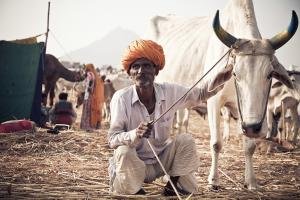Can cows on the Indian subcontinent help us fight kala-azar?

The cow is treated as sacred by Hindus in India and Nepal. The milk, curd and butter produced by the cow nourish the children and the cow dung provides energy for the household but the cow asks nothing in return. Most rural families in the Indian subcontinent have at least one dairy cow who is often treated as a member of the family.
Kala-azar, a deadly parasitic disease transmitted by sandflies, is also well known by those families. This disease, also known as visceral leishmaniasis, affects the poorest rural communities in North India and South-East Nepal. Kala-azar can be treated but, as there is no vaccine, it can only be prevented by avoiding the bite of infected sand flies.
Can cows help us fight against this disease on the Indian subcontinent?
Sure, they already do so by providing crucial nutrients and energy to the inhabitants of those communities: malnutrition is believed to be one of the risk factors associated to the development of kala-azar. But cows can also help in less orthodox ways. They can help us evaluate vector control tools in endemic areas. In a recent study in a rural village in Nepal, cows helped us compare the barrier effect of different types of nets against sand flies.1 As Phlebotomus argentipes, the vector of the Leishmania parasite in the area, like to bite cows we placed them under different types of nets and evaluated the number of sand flies that were able to cross the net barrier. We compared insecticide-treated and untreated nets as well as nets with different mesh sizes. The study showed that treating nets with insecticide and reducing the mesh size significantly increased the barrier effect against P. argentipes. This is just a proof of concept study using entomological indicators. The efficacy of any new vector control tool against kala-azar in humans must be evaluated in a randomized controlled trial using clinical outcomes.
The use of cows, that are resistant to Leishmania infection, as bait allowed a rapid evaluation of different nets under field conditions. The study was funded by the Royal Society of Hygiene and Tropical Medicine; ISGlobal (Spain), BPKIHS (Nepal) and BASF (Germany) contributed to its success. However, the cows, always ready to help, and their owners were the key actors in this story.
Reference
1. Das ML, Rowland M, Austin JW et al. Do size and insecticide treatment matter? Evaluation of different nets against Phlebotomus argentipes, the vector of visceral leishmaniasis in Nepal. PLoS One 2014 Dec 10;9(12):e114915. doi: 10.1371/journal.pone.0114915. eCollection 2014.